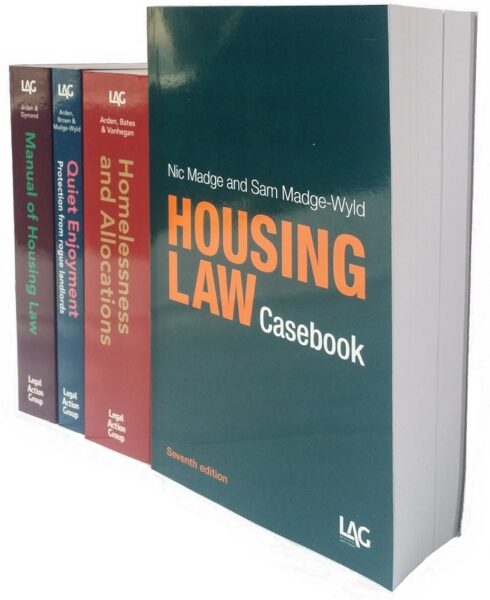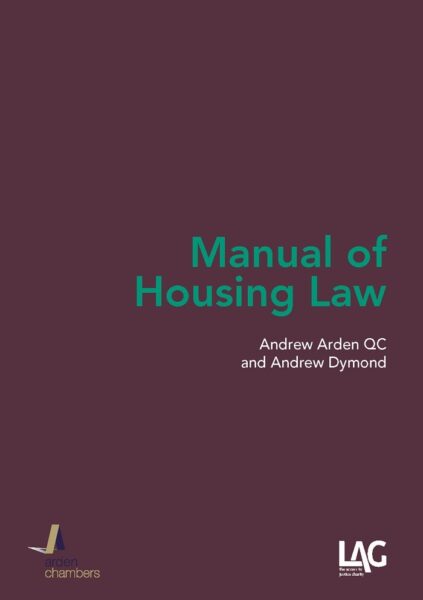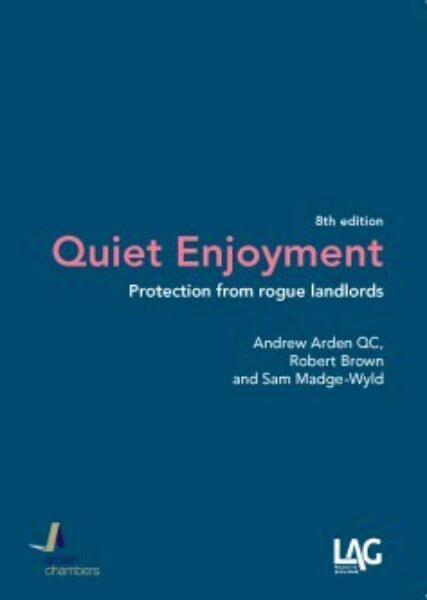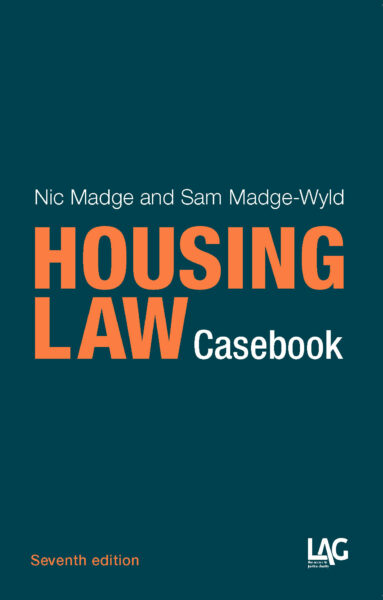Four new housing law titles from Legal Action Group
Legal Action Group have recently published four new housing law books. If you work in housing and regularly need to check the law it's well worth checking them out.

Housing law is constantly changing as successive governments repeatedly make piecemeal changes.
This might be great for lawyers but it makes life rather difficult for the rest of us. In fact it's a full time job keeping up.
Thankfully these four books go a long way to helping you make sense of the complexities of the current legal landscape.
LAG publications are often the best possible starting point for getting an introduction to a particular area of social welfare or public law. I know this from personal experience. When I was a paralegal their texts helped me learn about key legal concepts and how they operated in a housing context.
It helps that LAG's books take a practical rather than an academic approach. It also helps that the authors are judges, barristers and solicitors who have practiced and written about housing law for decades. Three of the following titles are co-authored by Andrew Arden QC and all four are co-authored by barristers from Arden Chambers.
So how do they shape up? And should you buy them?

'Manual of Housing Law' by Arden & Dymond (10th ed)
20 years ago a former colleague recommended I should get the Manual of Housing Law. He said that if you only going buy one housing law book this should be it.
The aim of this text is incredibly ambitious: to provide a one-stop-shop housing law reference book in under 600 pages that works for a variety of individuals, e.g. lay person, housing officer, adviser, student, environmental health officer, councillor etc.
There are chapters dealing with such issues as types of occupation, security of tenure and eviction, rent and other property charges, regulation of social landlords, homelessness & allocations, disrepair, and housing conditions.
You won't find every issue dealt with in detail. But if you need to quickly identify the key legal principles in relation to a particular subject and need to know where to find the relevant law then this might just be the book for you.
So, for example, a chapter dealing with the range of powers available to local authorities and social landlords to combat antisocial behaviour distils all the statutory provisions into less than 10 pages.
At £60 the manual is a lot cheaper than the previous edition, which was published by Sweet & Maxwell. This is testament to LAG's commitment to making their books affordable.
The only other text that so satisfactorily fulfils a similar purpose is another LAG publication: the excellent Housing Law Handbook by Diane Astin.
Personally I prefer the Handbook. It's specifically aimed at housing advisers who are acting on behalf of occupiers and housing applicants. But it benefits from being larger and having a more practical approach, with the text being based around the most common housing problems people encounter. Issues are also illustrated with selected case law summaries. In addition each chapter starts with a summary of the key points covered.
If you're looking for an all encompassing housing law reference book I'd suggest you compare the contents and downloadable chapter of the Manual (which I understand will be available shortly here) with the contents and sample chapter from the Housing Law Handbook. Bear in mind however that the Handbook doesn't cover developments after March 2015.
When I need to quickly look something up I'll be torn about which one to pick off the shelf.

'Quiet Enjoyment: Protection from Rogue Landlords' by Arden, Brown & Madge-Wyld (8th ed)
This book has previously concentrated solely on the law governing the rights of occupiers to protect themselves against unlawful eviction and harassment by landlords.
So the various causes of action for unlawful eviction and harassment, in contract and tort, are thoroughly explained as well as the relevant criminal offences.
But with this new edition the authors have made a smart move by expanding its scope to a range of other problems caused by 'rogue landlords'.
So the issues covered now also include:
- protection of tenancy deposits
- licensing of landlords and agents
- energy efficiency duties
- safety duties (including gas, fire, electricity and smoke alarms), and
- retaliatory eviction.
This breadth of coverage means that Quiet Enjoyment will be incredibly useful if you advise private tenants.
A chapter on banning orders and the database of rogue landlords is particularly timely, since Part 2 of the Housing and Planning Act 2016 is due to come into force shortly.
At only 260 A5 sized pages the commentary is necessarily concise. But this ensures that an excellent introduction is provided to the wide range of statutory provisions regulating landlord behaviour and affecting the ability of residential occupiers to enjoy their home.
The appendices include extracts from the numerous statutes and regulations referred to throughout the text. For legal practitioners there's precedents, chapters on bringing civil proceedings and criminal proceedings, and an appendix giving examples of damages awarded in the county court for unlawful eviction and harassment.

'Homelessness and Allocations' by Arden, Bates & Vanhegan (10th ed)
For 35 years this has been the leading text on homelessness and the law governing social housing waiting lists.
This edition retains the previous structure. So there are two introductory chapters providing a history of how the legislation has developed and an outline of homelessness and allocations law.
There are then chapters on each of the 'hurdles' governing entitlement to help for homeless people: eligibility, homelessness, priority need, intentional homelessness and local connection.
The chapter on homelessness decisions is particularly impressive. It explains the law governing applications for assistance, the procedures councils must follow, and the law concerning inquiries, decisions and internal review of decisions. All in 65 A5-sized pages.
While in recent years Arden has gained a rival (in Luba et al's Housing Allocation and Homelessness) one can see why it retains its place as a staple on the homelessness professional's shelf.
Its strength lies in how the commentary concisely explains key principles. There are countless examples of judgments being summarised in two or three sentences. The text manages to introduce legal principles while at the same time concisely expounding the complexities.
The first part of the chapter entitled 'Enforcement' - which explains the public law grounds on which decisions can be challenged - should be compulsory reading for new homelessness and allocations officers. Each ground is illustrated by homelessness and allocation cases that apply the public law principles.
The book is so well structured that once you've used it for a while it's remarkably easy to find the section dealing with your query. This is helped by each chapter having a contents page which more often than not enables you to quickly identify where you should be looking.
As you'd expect the text incorporates recent case law developments. But the forthcoming changes under the Homelessness Reduction Act 2017 are also explained. Helpfully the changes are mostly detailed within the existing commentary, so you can see how they relate to the existing law.
What can't be covered is the yet to be published draft Code of Guidance or statutory instruments. I suspect a new edition will quickly follow next year to incorporate these developments.
The appendices include a full copy of the English statutory guidance and amended versions of the main Acts of Parliament and regulations. The latter two are worth the purchase price alone, particularly if you don't subscribe to a legal database. After all, you can't rely on www.legislation.gov.uk to provide up to date legislation. Part 7 of the Act is reproduced and includes the forthcoming amendments under the 2017 Act.
I suspect those of you who've owned a previous edition don't need a review to know it's time to make a purchase. If you work in homelessness or housing advice you really can't afford to be without a copy.
However unlike the previous edition you don't get a cd containing a pdf version of the book. Rather the electronic version has to be purchased separately via Amazon.
This seems rather short sighted. No scrub that. It's actually very annoying if, like me, you'd routinely use both the hard and electronic copy. Having both can be a necessity if you regularly work away from the office or want to search the text for a particular phrase.
Consequently I must admit to feeling short changed. You're effectively forced to choose between the book and electronic version, unless you're willing to fork out twice (with the ebook being only slightly cheaper).
Notwithstanding this bugbear if you work in homelessness or give housing advice it'll be in constant use.

'Housing Law Casebook' by Madge & Madge-Wyld (7th ed)
This book does what it says on the tin. It summarises hundreds of housing cases.
Using the Casebook is often more productive and enjoyable than using a legal subscription service such as Lawtel or Westlaw.
There are several reasons for this. Firstly the summaries are organised by subject. Each chapter (say, assured shorthold tenancies) is sub-divided into sections dealing with distinct issues (for ASTs: requirements for a tenancy to be an AST, section 21 notices and tenancy deposit protection). To take another example if you're looking for case law on the possession grounds relating to antisocial behaviour you just go to that section within the 'Grounds for Possession' chapter.
Cases are listed within each section by hierarchy of the court, e.g. Supreme Court, then Court of Appeal, High Court and so on. You can therefore quickly find the leading cases.
In addition most sections have a short introduction summarising the relevant statutory provisions. This ensures that you can quickly get to grips with the context in which the cases were decided.
County court cases are included where appropriate, for example in relation to damages for disrepair and unlawful eviction. Cases from other jurisdictions are also sometimes included where they illustrate points of law that have been argued.
Another strength of the Casebook is that each case is introduced by a one-sentence summary. These often encapsulate the ratio of the judgment so effectively that you quickly recall the particular case (or know that it's not the case you're looking for).
Where a case is relevant in more than one context a section may list the name of the case, its citation and a one-sentence summary before referring you elsewhere for the full entry.
Some areas of housing law have been omitted, for example the enforcement of housing conditions and HMO licensing under the Housing Act 2004. However, as the authors point out in the introduction this enables comprehensive coverage of those areas that are included.
By LAG's standards the £70 price tag is quite pricey. However, as with previous editions, a couple of hundred pages have been added so as to accommodate recent developments. At over 1,300 pages it's a bit of a monster.
The purchase price includes the ability to register for Housing Law Casebook online. The online service provides a searchable database. What's more it's regularly updated to incorporate post-publication cases.
The Casebook isn't designed to be a substitute for the law reports. But if you regularly need to locate cases and obtain an overview of the issues decided it's indispensable.
In fact it's one of those texts where you're left wondering how the authors managed to compile something so comprehensive, well written and well organised.
The Welsh Dimension
Quite a few of you who read the blog are in Wales. It's therefore only fair that I point out which of the books incorporate Welsh provisions where they differ.
As Nic Madge and Sam Madge-Wyld point out in the introduction to the Housing Law Casebook:
While we can only commend the devolved assembly in Wales for its decision to implement the Renting Homes (Wales) Act 2016, paradoxically it is only going to make the law more complicated for those who practice in both England and Wales
Truth be told the divergence of housing law either side of Offa's Dyke predates the 2016 Act. Although it's certainly true that they'll be a step change next year once tenancy law in the principality is recast.
I imagine this rapidly increasing divergence presents a dilemma for authors and legal publishers. Do they spend extra time and money incorporating Welsh law? It's doubtful to pay off in terms of sales. And might English readers find the extra content distracting or unhelpful?
Incorporating the Welsh dimension is however good practice and useful for comparative purposes. You only need to consider the Homelessness Reduction Act 2017 to see the impact of housing competence in Wales thus far.
Both the Manual of Housing Law and Homelessness and Allocations covers both England and Wales, mostly by synthesising the separate provisions within the same sections.
However for reasons of space the Welsh legislation and statutory guidance is not reproduced in the hard copy of Homelessness and Allocations. Welsh readers might therefore prefer the ebook which reproduces Part 2 of the Housing (Wales) Act 2014 and associated regulations and guidance.
Similarly Quiet Enjoyment incorporates English and Welsh law where it differs. Its chapter on the licensing of landlord and agents is particularly useful, as it covers the new Welsh licensing regime under Part 1 of the Housing (Wales) Act 2014, the associated offences and the differences in Wales in respect of rent repayment orders.
The contents of the Housing Law Casebook illustrate the lack of 'Welsh' caselaw. However case law will often remain relevant even where Welsh housing legislation differs because it contains similar provisions.
Helpfully the Casebook retains the 'old' case law in relation to vulnerability and homelessness in a separate section because of its continuing relevance in Wales.
So, those working or practising in Wales (or in Wales and England) who use LAG texts will be reassured.
As for the additional texts mentioned above, Diane Astin's Housing Law Handbook only covers the law in England. However, Luba et al's Housing Allocation and Homelessness provides lengthy commentary on all aspects of the Welsh law governing housing applications.
Forthcoming for Wales
If you work or practice in Wales you should also keep an eye out for LAG's forthcoming book on Welsh housing law. Written by Arden Chamber's Justin Bates it's due out next year, to coincide with the Renting Homes (Wales) Act 2016 coming into force.
Discount offer
If you buy the first three of the above LAG titles (i.e. not the Casebook) you can get a discount of £32 off the total cost.
Posted in category: Resources Books & publications
Comments